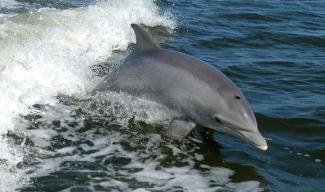
There are 15 species of dolphin and one species of porpoise found in Australian waters and all of them are protected by the Environment Protection and Biodiversity Conservation Act 1999.
Sometimes dolphins may interact with fishing boats that use trawl or gillnet gear.
Biology
Dolphins and porpoises are marine mammals also known as cetaceans. They are found in a variety of marine habitats, from the open ocean to coastal bays and inlets. Dolphins are migratory animals and their habits vary. Species that live in coastal areas are less likely to travel compared to species that live in open water.
Dolphins are active predators and eat a variety of food depending on availability. They often eat fish, squid and crustaceans. Sometimes dolphins can cooperate as a group when hunting fish. Other times they can follow fishing vessels and feed during fishing operations.
Fishing and dolphins – how they interact
Dolphins can interact with fishing boats that use trawl or gillnet gear.
An ‘interaction’ is any physical contact a person, boat or fishing gear has with a protected species that causes the animal stress, injury or death. Interactions with dolphins can happen when boats are trawling or when the dolphin gets caught in a gillnet.
Interactions with dolphins are rare and unpredictable.
Monitoring interactions
AFMA collects data on interactions with protected species through our monitoring programs.
- Logbooks – All fishers are required to report any interactions they have through their logbooks.
- Dolphin Bycatch Evaluation Report (Gillnet Sector of the Southern and Eastern Scalefish and Shark Fishery) All fishers are required to supply management with additional information following dolphin bycatch.
- Dolphin Bycatch Evaluation Report (Small Pelagic Fishery) All fishers are required to supply management with additional information following dolphin bycatch.
- Observers – Observers are AFMA officers who travel on Australian fishing boats to collect biological data and make environmental observations which contributes to the monitoring of fishing interactions with protected species.
- Electronic monitoring – AFMA has electronic monitoring systems on some fishing boats. These systems have sensors linked to surveillance cameras that record fishing activity including bycatch of dolphins / Australian sea lions. These recordings can then be collected and monitored by AFMA to help management understand the nature and extent of these interactions.
Links
How AFMA and industry minimise interactions
The Commonwealth Fisheries Marine Mammal Working Group has been established to provide advice to AFMA on marine mammal management arrangements across all Commonwealth managed fisheries.
The Working Group has been structured to elicit the best possible advice from a wide variety of stakeholder groups including marine mammal scientists, the commercial fishing industry, the conservation sector, recreational / charter fishers and members from government agencies such as AFMA, the Department of the Environment and Energy and the Department of Agriculture and Water Resources. The Working Group also has an independent Chair.
Interactions between dolphins and fishing gear occur in the Small Pelagic Fishery (SPF) and the Gillnet Hook and Trap sector (GHAT) of the Southern and Eastern Scalefish and Shark Fishery (SESSF).
To mitigate dolphin interactions in these fisheries, AFMA has:
- revised the 2014 Gillnet Dolphin Mitigation Strategy and extended it across the whole gillnet sector
- implemented a new SPF Dolphin Mitigation Strategy for all trawling methods.
The strategy works on an ‘individual accountability’ approach. This means that fishers who do not interact with many dolphins are able to continue fishing, while those who have a higher level of interactions are subject to escalating management responses.
The Dolphin Mitigation Plans for the Small Pelagic Fishery and the Gillnet sector of the Southern and Eastern Scalefish and Shark Fishery outline the actions taken by each operators to minimise dolphin interactions on that particular fishing operation.
Download a copy of the Dolphin Mitigation Plan Template (Gillnet Sector of the Southern and Eastern Scalefish and Shark Fishery).
Download a copy of the Dolphin Mitigation Plan Template (Small Pelagic Fishery).
Protected species that are identified as high risk bycatch species are dealt with through bycatch and discard workplans for each fishery. The workplans are integrated into the management arrangements for each fishery, and are reviewed every 12 months and formally renewed every two years.
Read more about bycatch and discarding workplans.